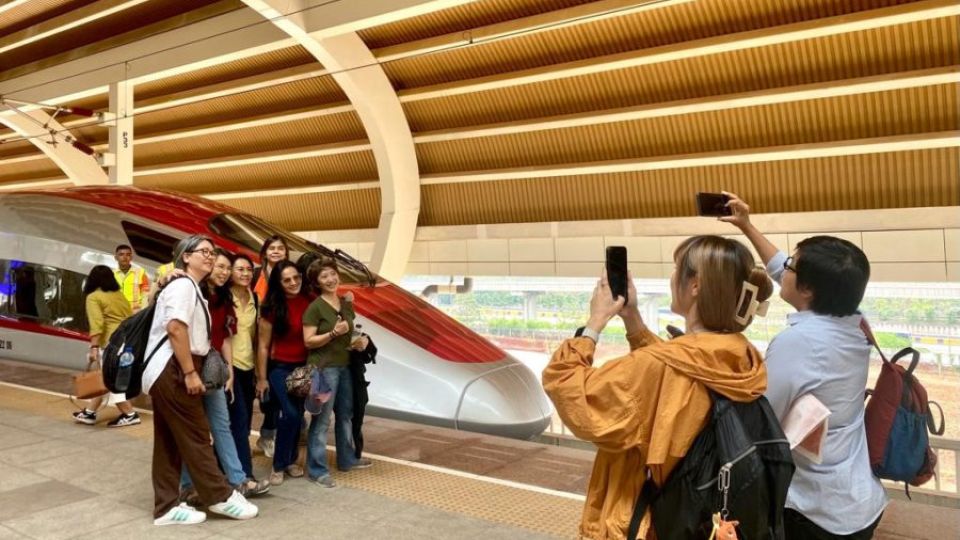November 29, 2023
JAKARTA -Zipping from Halim Station in Jakarta to Tegalluar Station in Bandung regency in 45 minutes, the Whoosh, Southeast Asia’s first high-speed railway (HSR) service, has piqued the interest of many travelers.
The scene preceding the journey is one of orderly queues, seamlessly swinging check-in gates and abundant signage guiding passengers to the right platform and carriage and swiftly into their reserved seats.
Shu Qing, Xinhua’s photographer in Jakarta, had just finished his 20th Whoosh trip as he shared his impressions with journalists on Wednesday: “I always feel happy on the HSR, especially when it hits 350 kilometers per hour. Every time I travel from Jakarta to Bandung, it feels like a journey back to China.”
Each ride was a blend of “pure delight and a testament to modern transportation marvels”, Qing reminisced, recalling the joy he witnessed among fellow passengers in his carriage breaking into applause each time the train hit its top speed.
University of Padjadjaran student Li Tianchong, called Yoga by his friends in Indonesia, slept through part of his first ride: “’I dozed off for a bit during the ride, and when I woke up, I was confused for a moment. Is this heading to my hometown or somewhere else?”
“Oh, turns out it’s taking me to my second home, Bandung,” the Chinese student said humorously, adding that the moment of realization came upon observing the megamendung batik motifs adorning the seats and highlighting a cultural connection between China and Indonesia.
China Daily reporter Guo Rong shared the same sentiment: “It’s a familiar experience, very similar to China’s high-speed rail, very satisfying and boasting similar amenities.”
Rong emphasized her preference for HSR: “Even in bad weather, HSR ensures uninterrupted travel. It might come with a higher price tag than regular trains but with significantly shorter travel times,” she concluded.
Dewi, 36, organized a day trip to Bandung with two friends that had them catch the earliest train at 6:30 a.m., explore the city and return on the 5:50 p.m. trip.
They had chosen Halim as their meet-up spot, with Dewi praising the HSR departure station’s accessibility: “There are many options to get to Halim [from various corners of Jakarta], and the traffic wasn’t too bad.”
While the journey proved satisfying for the three, she underscored that whether she would opt for the HSR in future hinged on the trip’s purpose, duration, the number of people involved and the destinations.
“Today, with the girls, it was spot on, but if I’m traveling with my family for a longer Bandung stint, I’d choose a car considering the cost,” she noted. “Especially if the fare increases.”
Promotional price
While passengers appreciate the speed and convenience of the Whoosh, affordability remains a pivotal factor. Many passengers say they will revert to their previous transportation choices when the fares rise.
Dewi elaborated: “I was just discussing this with my pals. Once it goes above Rp 300,000 (US$ 19.37) per person for a trip, it starts biting into the wallet, especially when you weigh it against hopping into a car,” Dewi noted.
“For business trips, however, the speed might just make it worth the price,” she continued.
Restu, 27, a frequent passenger for business purposes, opined that the service was well connected with feeder buses and the LRT in Jakarta.
“This is my fourth time on the HSR, and for now I still prefer it, as the fare remains reasonable and it’s swift getting into the city,” she said.
However, she stressed the importance of pricing. “If the price doubled, I would opt for the regular train, unless the office covers the cost. Speed’s a plus, but the price tag matters.”
Yoga sympathized with that viewpoint: “As a student, my options depend on my wallet. If I have enough money, I will choose the HSR, but if not, I will choose the regular train.”
The HSR operator, PT Kereta Cepat Indonesia China (KCIC), has expanded the period of the special price of Rp 150,000 for a premium economy class seat to the end of the year.
KCIC disclosed on Monday that the average occupancy rate had soared to 98.5 percent within weeks of the start of commercial operations, prompting the operator to increase supply from 14 to 36 trips per day.
The operator added it was now accommodating an average of 18,000 passengers daily, and hit a ridership peak of 21,312 passengers on Nov. 12.
Six-and-a-half percent of those were first class and business class passengers, while the majority traveled in the premium economy class.
Transit woes
While praising the convenience of the ride itself, travelers were less impressed with their options in Bandung regency, where the HSR stops first at Padalarang to the west of Bandung city and then at Tegalluar to the east of the city.
Many travelers alight at Padalarang Station to resume their journey on a feeder provided by state-owned railway operator PT Kereta Api Indonesia (KAI).
Dewi said the feeder service was less comfortable than the HSR trip. She described her transit experience as rushed and not smooth and said the schedules of the two services were not well synchronized.
“The feeder was overcrowded, with people standing, and when we arrived at the [HSR] station, we had to rush to catch the train, all within a tight two-minute window,” Dewi recalled her experience of catching the HSR after departing from central Bandung on the feeder.
Ikhwan, 18, who works as a cleaner on the Whoosh, described a slightly different commuting ordeal. His trip from Bandung Station in the city center to Tegalluar Station involves two parts using different modes of transportation.
“I take the local train from Bandung Station to Cimekar Station, then hop onto a friend’s motorbike to reach [Tegalluar] Station. Each one is a 15-minute ride,” he said, adding that it was “too bad that there’s no direct link to the [HSR] station at all.”


